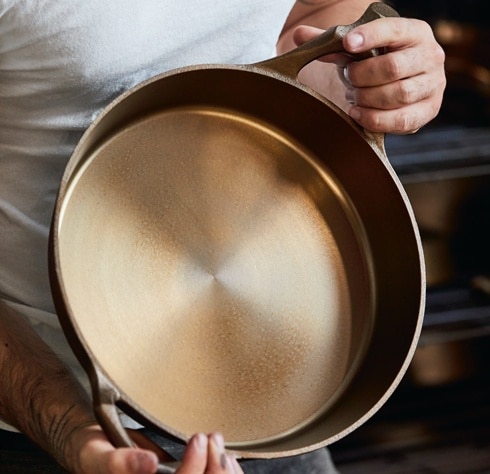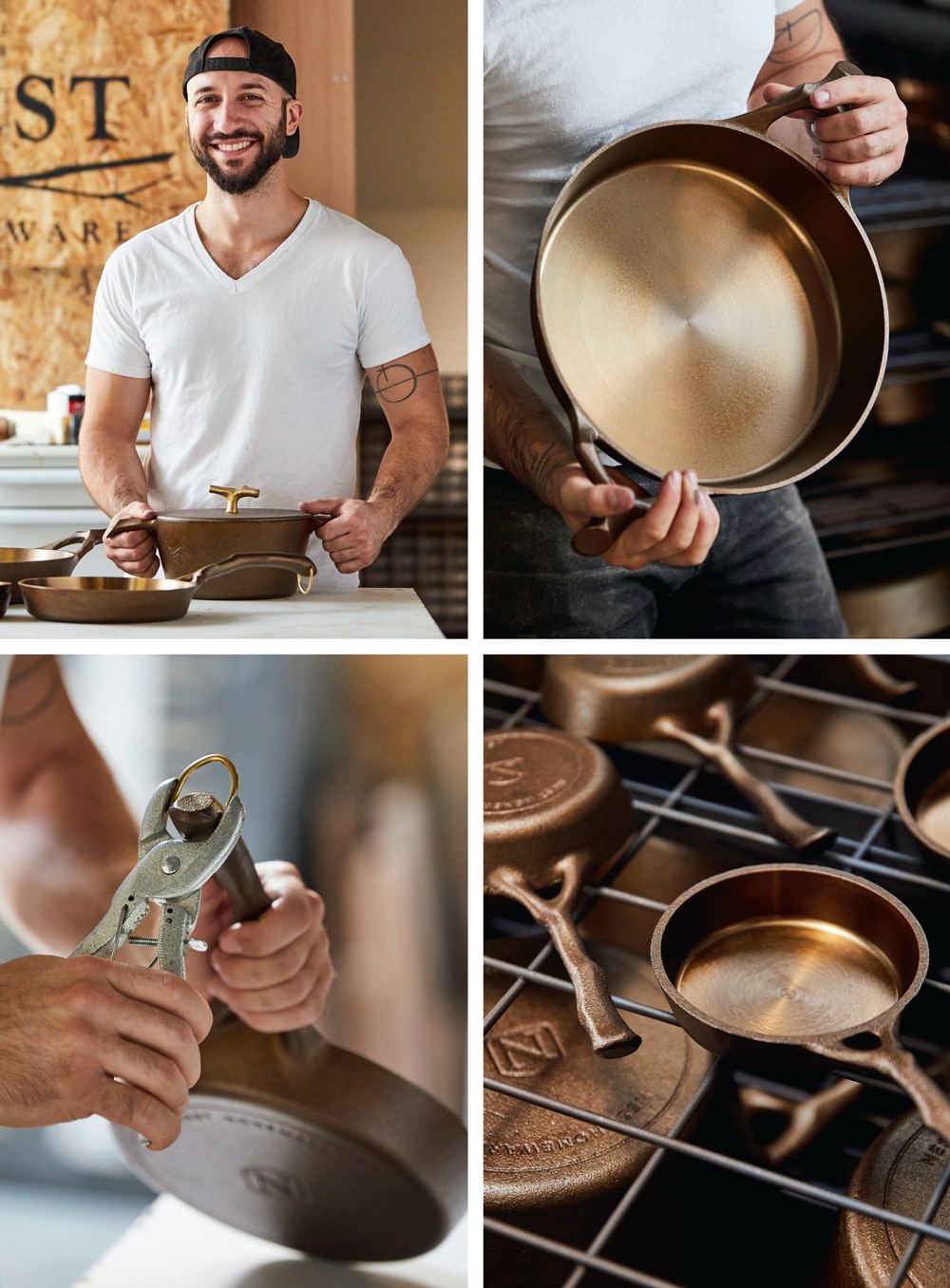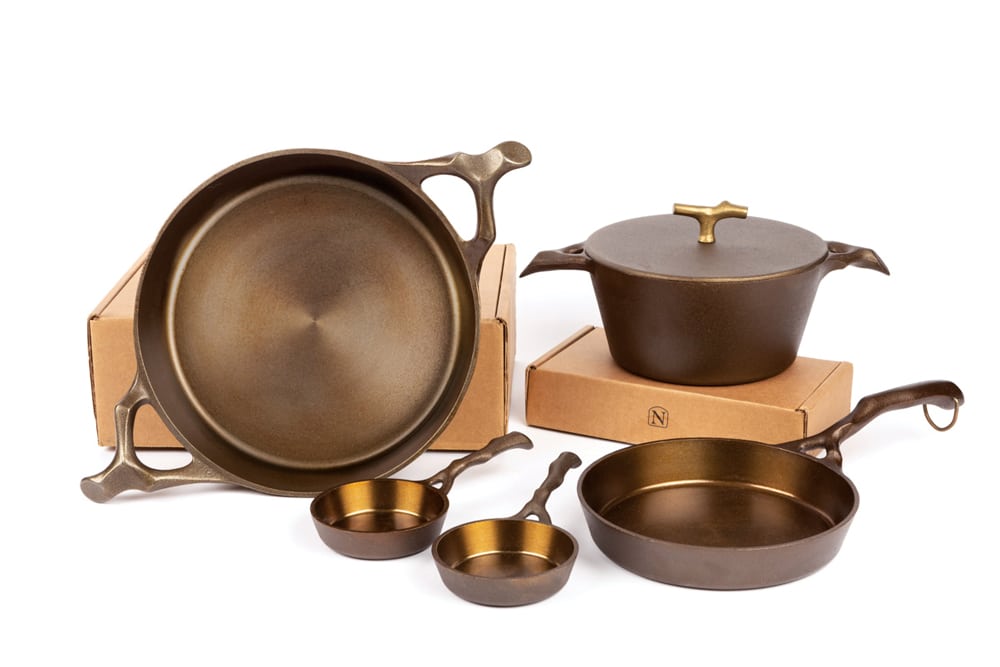Forging the Future with Rhode Island Metal Artisan Matt Cavallaro
Rhode Island’s Matt Cavallaro turns ancient know-how into strikingly modern cookware.

To cast iron, you need heat, sand, and metal. That’s it. Everything else is peripheral.
In a different setting and a different time, Matt Cavallaro might pass for a medieval craftsman—something about his close-cropped beard, his skill with the metal arts, the intensity of the way he handles the object at hand. Instead, we’re deep into the tangled innards of a squat brick industrial building in Providence, Rhode Island, and Cavallaro, 32, is sporting plastic safety glasses atop a black knit cap. In fact, he is a study in black, the black of well-worn cast iron, from jeans and hoodie to down vest and even his beard. His smile is open; his brown boots have scuffed around the block a few times.
“The cast iron process is thousands of years old,” he says, warming to his subject. “Other than pottery, it’s the most ancient production process. There are limits to it, but there is so much possibility and freedom. If you know the constraints, you can work within them to really push the boundaries.”
We’ve just wandered through a forest of metal shelving, past rugged workbenches and heavy chains dangling from the ceiling, light filtering down through skylights. Fabricated metal shapes hang from the walls; an anvil looks on. Cavallaro shares this cavernous maker space with several design friends, but the boundaries seem fluid. It’s hard to tell where one workshop leaves off and another begins, except for this small pod of a room that Cavallaro carved into a corner to house the seasoning oven—a gray hulk that looks like an impregnable safe—and his shipping operation.

Photo Credit : Pat Piasecki
The prettiest thing in this very basic room is a little stack of burnished pots sitting on a metal stool. They glow like bronze, but they’re cast iron. Nearby are two small black skillets glistening with oil, their handles gnarled into the shape of branches. These are among the items Cavallaro used to launch Nest Homeware in 2013, with the help of Kickstarter, just three years after graduating from the Rhode Island School of Design.
“I designed the original collection—egg pan, nine-inch skillet, three-and-a-half-quart Dutch oven—all at the same time, because I felt that there was a lot of strength in launching with more than one product,” Cavallaro explains. “You can try to make one thing that does it all, but it’s never going to do everything well.”
What Cavallaro himself does well, he freely admits, is relate to the process. “I fell in love with it, the pattern making,” he says. “From an early age I really was intrigued by mold making, and this process is entirely mold making and casting.” He shakes the pot lid he’s holding, for emphasis. “I think really well in a mold. And it tends to be how I move through a lot of projects.”
So Cavallaro talks me through this ancient process, first showing me the “positive,” a 3-D pattern that he sculpts by hand, and then the “parting line,” which is where he splits it. The two halves are mounted to two sides of a board; a box filled with hard-packed sand is lowered onto each half. When the pattern is removed, that imprint becomes the mold to be filled with molten metal at the foundry.
He emphasizes the importance of that early hand-sculpting, though eventually he resorts to a computer program to build the pattern. “But it would be impossible, I think, to come up with a form this nuanced on a computer. It does what it wants, not necessarily what I want.” He hands me the skillet. “And it won’t know what feels good in your hands. These particular products—they need to start with the hand.”
They finish with the hand, too. Although he uses an out-of-state foundry, the seasoning and the shipping happen here, with Cavallaro and his partner, Rue Sakayama, handling every piece of cookware, seasoning it with flaxseed oil in the unassuming-looking oven. Over time, and with use, the color will darken, deepening to the rich black of antique cast iron.

Photo Credit : Pat Piasecki
Cavallaro grins and makes a comment about his great love of fantasy, sci-fi, and “medieval stuff.” He is pleased with how these iron pots have materialized into the world. The ancient remains relevant—and revelatory. “That experience of watching molten metal take shape, it does not lose its charm,” he says. “I don’t think it ever really will. It is magic, every single time.
“Previously I’d thought that product design was almost evil—kind of unnecessary and wasteful,” he continues, remembering his RISD days. “When I saw what was possible with an ancient material that’s truly recyclable, it was like—oh, if I work with this I can make something that’s going to last forever. And maybe that’s worthwhile.”
For more information about Cavallaro’s work, go to nesthomeware.com.
Annie Graves
A New Hampshire native, Annie has been a writer and editor for over 25 years, while also composing music and writing young adult novels.
More by Annie Graves

